- Report: Ayahuasca Symposium UK - June 26, 2019
- Psychedelics and Blockchain: Two Technologies Key to Our Future - January 9, 2019
- Ayahuasca to help victims of genocide in Iraq? - September 19, 2018
Introduction
On Sunday, June 23, I attended the first “Ayahuasca Symposium” in London, UK, on behalf of Chacruna, a partner to the event. The event, organized by Anya Oleksiuk of the UK Psychedelic Society and Benjamin Mudge, aimed to integrate academic and spiritual worlds. Talks introduced the sacred Amazonian plant medicine ayahuasca, related contemporary issues, and the community that has emerged around it.
The conference took place on one day in a historic building in Hackney. There were nine speakers providing a range of presentations and information. The day began with music and smudging and ended with a cacao ceremony, more music, and a DJ set. There was an outside space and plenty of time for community connection.
Anya comments, “At a time when ayahuasca ceremonies have become popular, but are still misunderstood and legally-persecuted spiritual practices, the Psychedelic Society intends to provide a balanced approach to the facts, issues, and best practices surrounding this ancient plant-based medicine. Curated by psychedelic luminary Benjamin Mudge, this event welcomes a line-up of internationally reputable speakers and soulful musicians.”

The talks

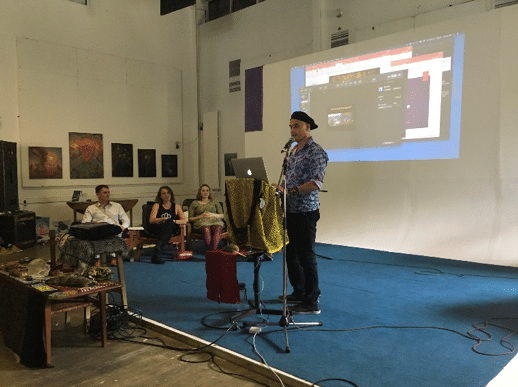
The day began in the outside space with a ceremonial and musical session led by Don Gino Chaka Runa and Silvio Nardo, alongside other musicians and sage smudging. Benjamin Mudge gave a general introduction on the basics of ayahuasca.
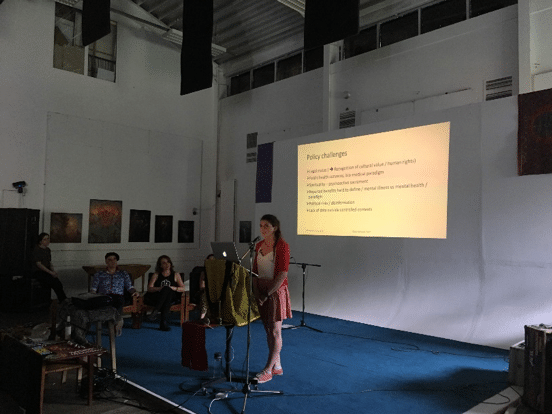
Helena Aicher outlined results from the large-scale survey conducted by the Global Ayahuasca Project. This has amassed over 7000 responses so far. Respondents were typically 25 – 35 years old, had drunk 2 – 5 times, and stayed with a single group of drinkers. Top motivations to drink included “Increased spiritual awareness and connection,” “To gain insights into my life, purpose, and emotion,” and “to improve personal relationships.” Very few said “I just wanted to get high.”

Charlotte Walsh, a UK-based lawyer with the ICEERS Ayahuasca Defense Fund, gave a solid outline of the legal situation regarding ayahuasca, particularly in the UK. She detailed the two main court cases that have been brought in UK case law. Walsh critiqued the positions of both prosecution and defense, and problematized the placement of the right to drink ayahuasca within the bounds of religious freedom. Instead, she said it is a much broader issue of human rights, including rights to autonomy and cognitive liberty. Her position is that current drug laws are not just inappropriate, but also incorrectly applied.

Tom John Wolff gave a presentation on ayahuasca tourism in South America. He noted the romanticized fantasies that Westerners often have about ayahuasca, exhibited via preferences for ceremonial headdresses and paraphernalia. There is a “fluid religiosity, neoshamanic beliefs, and a romantic image of ‘Indian’ wisdom.” He noted, “Tradition is not a fixed dogma, unchanged through the centuries, but is formed and shaped by each new generation. Tradition can be produced and re-invented.” Wolff found that foreign visitors tend to be white, well-educated, middle class, and around 30 years old, with previous drug experiences and experience of self-optimizing techniques.
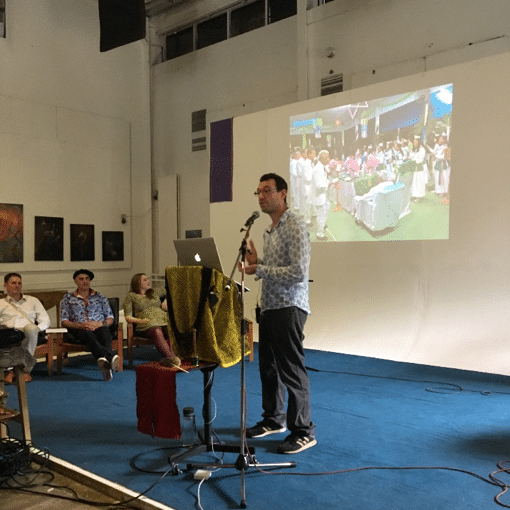
Danny Nemu, author of “Neuroapocalypse” and “Science Revealed,” spoke about Brazilian ayahuasca religions, including Barquinha and the Uniao de Vegetal (UDV), particularly his own tradition of Santo Daime, and also explained some of the background and origins of the beliefs, practices, and rules behind the Daime and its interactions with Christianity. Nemu identified the importance of music and icaros and performed a few of these songs acapella, translating and explaining some of the lyrics. Nemu made connections to Western philosophy in the writings of Nietzsche and the art of William Blake.

Kerry Rowberry, PhD Candidate at the University of Cumbria, reported on ayahuasca ceremonies in the United Kingdom. She used an innovative form of visual ethnography based on the thinking of Deleuze and Guatarri, a “rhizomic analysis,” as opposed to the “tree-like structure” often presumed by other approaches. This involved an online process of data collection using mixtures of words and images generated by participants. Rowberry shared several of the artworks produced by participants and described her interpretation of meanings.
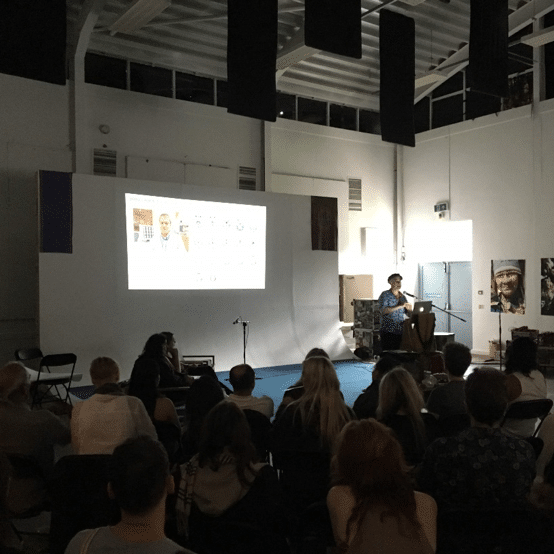
Benjamin Mudge, curator of the event, spoke on psychotherapeutic and psychiatric uses of ayahuasca. He described a range of contemporary research, including trials using a measured, dose-calibrated, pharmaceutical form of ayahuasca and MRI scans. He described the problems of trying to “blind” trials where ayahuasca is involved, due to the obviousness of its effects. Ayahuasca has been found to be an effective anti-depressant, using traditional scientific scales. Ongoing research is approved at Imperial College London and the Maudesley.
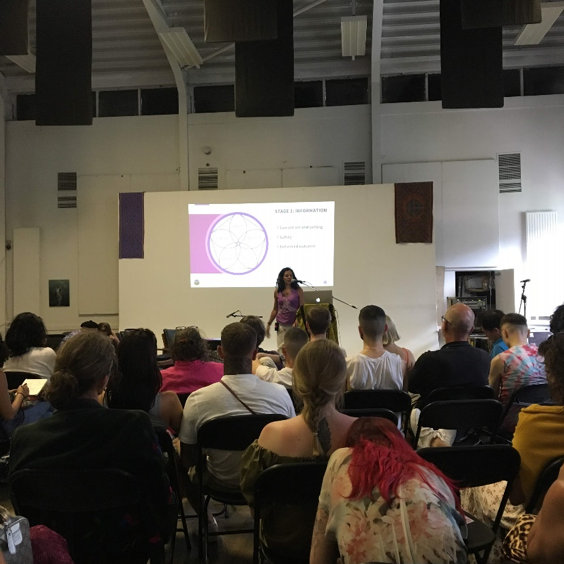
Sophia Vasiliou gave a presentation entitled, “Preparation and integration, before and after ayahuasca ceremony.” She detailed the four stages of information, preparation, navigation & integration. Vasiliou provided advice and guidance for each stage; particularly, for navigation and integration. These are described in greater detail in the two-day workshops and integration retreats that she runs. She discussed common difficulties and steps people can take to overcome them in their encounters with ayahuasca.
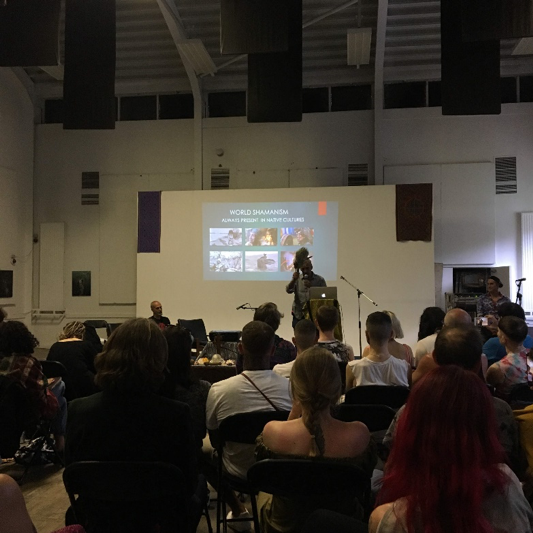
Don Gino Chaka Runa talked about “Peruvian Shamanism, and the spiritual journey of the ayahuasca ceremony.” He detailed and compared different traditions in Peru relating to ayahuasca, particularly the Andean traditions. Singing at points, Gino gave an informed background to contemporary ayahuasca use and advised people to seek out elders based in strong traditions. He noted his support for ICEERS and MAPS. He argued for much greater access, combined with proper respect and training. “The genie in the bottle is on the loose, and we don’t have any idea what our three wishes are.”
Detailed notes
Helena Aicher – Results from the Global Ayahuasca Project
- The Global Ayahuasca survey has 7000 responses so far. Representing six languages from 67 countries.
- A non-random cross-sectional survey investigating patterns of use, risks and harms, well-being and adverse effects, life changes.
- Respondents: 53% male, 47% female. High levels of education amongst drinkers taking the survey.
- Top motivations to drink are: ‘Increased spiritual awareness and connection’, ‘To gain insights into my life, purpose and emotion’ and ‘To improve personal relationships’. Very few said, ‘I just wanted to get high’. This was consistent across respondents from different countries.
- Age of first use is 25 – 35 in all regions, if slightly lower in Brazil.
- Most participants had drunk 2 -5 times, with a number (but not a significant percentage) in the 00s and 000s of times.
- Most people stay with one or two groups, not drinking in different groups each time.
- 21% have used other drugs at the same time, including 3.8% alcohol, a surprise.
- 56% drink regularly since first drinking.
- Most report that their ayahuasca experience is in the top five most spiritual experiences of their life
- There are ayahuasca ceremonies happening in all continents except Africa.
- Recreational use and abuse is all but non-existent.
- Individuals report benefits across a range of domains including emotional wellbeing, lifestyle, behavior and spirituality.
- ‘If we can’t explain data within a given paradigm, we need to change the paradigm’.
- Limitations: the survey is long and involved, taking up to an hour to complete, requiring a high level of motivation. There is a bias introduced by the self-selection of participants. For practical reasons many questions asked only about the single most recent experience, which may skew the data.
Charlotte Walsh – The legal status of Ayahuasca, ICEERS and the Ayahuasca Defense Fund.
- While ayahuasca is not typically prohibited, the DMT it contains is.
- This creates a legal question, which is answered in different ways in different places.
- Case law is then the main thing, rather than laws per se. This is the work the Ayahuasca Defense Fund engages with.
- The ADF try to counter the narrative that conflates the medicine with DMT. It’s a question of who owns the narratives, the story. And not just stories, but often an entirely different language, of, e.g. ‘drugs’ and ‘drug dealers’ vs ‘medicine’ and ‘healers’.
- One nation’s policy and decisions distinctly influence other nations. A move for or against ayahuasca in one place ripples out to other places.
- ‘We don’t want bad cases making hard law’. There is a possibility some other parties DO want that, to prevent the spread of ayahuasca.
- Here in the UK, the first case with Santo Daime was dropped due to ‘lack of evidence’. The authorities in this case had confiscating 80 liters of ayahuasca and also the dregs in a cup. It’s as if the prosecutors chose the Aziz case over the Daime one, to avoid having to deal with a properly structured and safe organization, against which they might lose.
- The UK has the Misuse of Drugs Act 1971, which mirrors the international situation more generally. This does not name ayahuasca, only DMT. But it also bans a ‘preparation that contains a prohibited substance’. So, the question is ‘what do we mean by preparation?’. Whether it’s a scientific process to extract it, or it’s a brew. There are different opinions on this.
- The English court determined that ayahuasca did constitute a preparation of DMT, making Aziz a producer and distributor of a prohibited drug. The ceremony was reduced to the brew, and the brew reduced to a single chemical contained within it.
- There is problem of the religious defense, a religion exemption, for drinking ayahuasca. Drinking is protected only if ayahuasca is a manifestation of religious belief. The reality is that ayahuasca is often the source, the generator of, the way to discover a religious belief. So the qualifying criteria are problematic, and exemptions based on religious use are problematic.
- There is a false dichotomy between individual freedom and collective safety. They are often assumed by the law to be at odds with each other. Because if many individuals use heroin, it causes societal problems. Yet, if many individuals use ayahuasca, that is likely to help society.
- There is corruption of logic that ‘the fact that DMT is illegal is because and proves that it is harmful’, as a way of avoiding the prosecution having to prove the harm of DMT in an ayahuasca context. It is an assertion.
- It’s not that there are no risks to ayahuasca drinking. It is that the blunt tool of the law is inappropriate to deal with those risks. Self-regulation would be enough.
- The prosecution put forward an argument that the intent of the drug laws was not discriminatory. The point is that the effect of the drug laws was discriminatory.
- International laws, including those regarding drugs, allow for national, constitutional exceptions.
- The court determined that the right to religious freedom was insufficient to allow any use of ayahuasca in ceremony in the UK. An appeal was declined. Apart from the fact the drugs laws should be scrapped, the judiciary failed apply the law appropriately in their own terms.
- The Misuse of Drugs Act allows organizations to apply for a licensee to import and distribute drugs. The UDV tried this, and the Home Secretary (Theresa May) declined. This decision was challenged, with significant resources at the highest level and failed. No judicial review was granted.
- Declining the judicial review was based on advice from the governmental advisory board Advisory Council on the Misuse of Drugs, citing a lack of clinical studies proving safety of ayahuasca. First, that’s incorrect, such evidence is available. Second, this assumes only one way of knowing, that only a randomized controlled trial can provide knowledge. Third, it shifts the burden of proof. The government need to prove harm rather than the church prove safety.
- Prosecution lawyers often assume a model of a standardization of dose. Traditionally the dose is seen as an art, not a science, coming from a different worldview, cosmology.
- Ayahuasca may be becoming a ‘victim of her own success’.
- Detractors often make a ‘floodgates’ or ‘slippery slope’ argument. This is a very poor argument. It’s a basic and immature error. The point of law is to draw lines, and there will always be something just on the other side of that line. That’s what the law is there to do: determine, as precisely as possible, where the line should be, and to censure the things that are past that line.
- Western medical doctors has reserved, for perhaps over a century, the exclusive, monopolistic right to issue drugs. They’re not going to give that power up without a fight.
- Because we’re human, we all have ‘mental health issues’. This is an issue for what constitutes appropriate screening of drinkers. We need to be careful of screening out people that would benefit.
- Charlotte is in favor of religious exemptions, but these don’t go anywhere near far enough.
- Prohibitionism compromises fundamental human rights: autonomy, privacy, cognitive freedom, spiritual exploration. These interfere with our freedom to become the best version of ourselves. What we choose to ingest is none of the state’s business.
- It is antithetical to the plant medicines to voluntarily create ‘in’ vs ‘out’ groups, e.g. ‘only those that subscribe to this religious can access ayahuasca’.
- The Denver (and Oakland) decriminalization is important, but mainly symbolic, assuming mushrooms were not a policing priority anyway.
- The EU Convention on Human Rights continues to apply after Brexit since it is not predicated on EU membership.
Tom John Wolff – Ayahuasca Tourism in South America
- Amazonian hotspots for ayahuasca: Cusco, Iquitos, Pucallpa and near Macchu Picchu.
- Jungle lodges are the main venue, specializing in foreign clients with pricing in US dollars.
- The frequency of usage of ayahuasca in these centers targeted at foreigners is much higher than would be the case for locals.
- These centers use ‘traditionalized architecture’ of wooden huts and shamans with a ‘native look’ of feather crowns, folkloric dressings.
- There seems a bias for tourists, anecdotally, towards the more indigenous-appearing ceremonies and away from those identifying as Christian.
- The question arises ‘With whom does the money stay?’ It is usually impossible to find an answer as a client.
- Recommends the article ‘Why You Will Never Get a Traditional Ayahuasca Treatment’ https://chacruna.net/you-will-never-get-traditional-ayahuasca-treatment/. Wolff’s take is that you can never get a traditional treatment because it’s your Western brain/mind/body that you take with you, which has the experience. We cannot step outside of our entire culture, upbringing, context, assumptions – even when we wish to.
- Traditionally, someone with serious issues would stay a long time in the house of the healer, with some exchange of labour or money. In modern times, the longer the client stays, the more money the shaman makes. This exchange can create ‘mountains of dollars’, which can provoke envy from other shamans, generating local politics.
- Foreigners use ‘healing’ in an imprecise and general way, without much thought.
- Locals often don’t wish to drink ayahuasca. The taste and difficulty of the experience puts them off. They pay the experts to do the work, to find out where the problems are in the village.
- The locals do not believe ayahuasca visions heal but merely provide information. It’s not about insight, psychotherapy. It’s less internal and more bodily e.g. ‘my knee hurts, what’s happening’, or about the external e.g. ‘business is slow, who is to blame?’.
- Shamanism is seen, by Westerners, as a rebellion against Western consumerist culture. There is a romantic misconception of ayahuasca as representative of and a way back to a time when people lived in harmony with nature.
- Paradoxically, seeking ayahuasca is typically an expression of exactly the Western ego, grasping and individualism that this search claims to transcend.
- Recommends the book ‘Singing to the plants’ for an overview of Mestizo shamanism.
- The cultural exchange is bidirectional. Now indigenous shamans may talk in terms of chakras, a foreign concept, due to the people they work with.
- ‘Tradition is not a fixed dogma unchanged through the centuries but formed and shaped by each new generation. Tradition can be produced and re-invented’.
- Foreign visitors tend to be white, well-educated, middle class, around 30 years old with previous drug experiences and experience of self-optimizing techniques. There is a ‘fluid religiosity, neoshamanic beliefs, and a romantic image of ‘Indian’ wisdom’.
Danny Nemu – Brazilian Ayahuasca Religions
- In the Daime tradition, they stay on their feet, symbolic of wanting to ‘take the work out into the world on their feet’.
- There is a sat-down ceremony with 17 songs once monthly, in his lineage.
- Preparation of the brew has 12 men around 12 stumps either in silence or singing songs, but not talking between themselves.
- The dieta is three days before and after, including no sex, no alcohol or other drugs. No watching zombie films. Clear the mind.
- The four ingredients: fire, water, leaf and vine.
- Daime is a ‘king and a queen’, rather than this talk of MAOI. Instead, ‘The king wakes up the queen, and the queen gives her light’.
- Music is central to the tradition. Icaros as a rhythmic sequence of syllables that helps harness and work with the forces of nature.
- The icaros are considered ‘received’ not constructed or composed.
- The idea is to rise up to meet the medicine rather than lie down and receive it.
- In the Daime tradition, there are rules against asking others why they didn’t attend, against inviting others vs their own volition and against expounding the benefits of ayahuasca (proselytising).
- Nietzsche, ‘One is the mere incarnation, mouthpiece, medium of an almighty power. I have never had any choice in the matter’.
- William Blake, describing his writing of Jerusalem as, ‘from immediate dictation, twelve or sometimes twenty lines at a time … almost against my own volition’.
- The connection between Blake’s an Amaringo’s psychedelic art.
- Daimistas are not allowed to make money out of their endeavors. This was part of the negotiation between mestre and Daime. If someone asks you to pay for a Daime ceremony, it isn’t Daime.
- Lyric, ‘Don’t be afraid of dying; if you run away, it’s only going to be worse for you’.
- Though Daimistas believe in reincarnation, you are not instructed to believe anything in Daime, just to observe the rituals appropriately.
- The Bible isn’t used, ‘The songs are the Bible, and the Daime is our teacher’.
- ‘Stop the ‘Bad news Post office,’ i.e. don’t gossip. Inviting people is a ‘fraternal error’.
- Traditionally in Daime, you drink ayahuasca every two weeks, it’s not just one or three times or occasional.
- There is a common vision of being dismembered and put back together.
- Obvious, observable interconnections between beings and spirits is considered common in the Amazon.
Kerry Rowberry – Ayahuasca ceremonies in the United Kingdom
- Ethnography as a type of anthropology interested in the cultural aspects.
- Rowberry conducted a ‘rhizoanalysis’, based on the metaphor of a rhizome. This an innovation of Deleuze and Guattari. In research, things are often put into tree-like structures. A common trunk with branches. Imagine instead a network with plateaus, offshoots. Phenomenology is messy. Reality is messy, but connected.
- After considering a physical art space for participants, Rowberry created an online forum to conduct the research.
- There were a series of visually-based activities/exercises to help participants express their experiences. Some used a mix of words, symbols and images. An ‘experiment in data collection methods’.
- Acknowledges ‘shamanism’ as the layman’s term, even if curandero/a is more accurate.
- Ayahuasca as a ‘new set of eyes’ from one participant.
- Green and the heart chakra seemed to come up a lot.
- One participant played with the word ‘Remind’. Resetting the mind, renewing the mind, re-minding.
- Conclusion: using an online space for activities of this nature is highly problematic. There are difficulties and variations in participant dedication and commitment. Deadlines had to be extended several times. It was difficult to give clear instructions remotely.
- Researcher bias is unavoidable.
- There was convergence on the idea of self-development.
- Themes: healing, transcendence, realms, plants. Questions, mother ayahuasca as the bringer of insight, the all-seeing eye. Spirituality, family, friends, health.
- The question of what ayahuasca shamanism means may be too big a question. Difficult to foster links and create themes. Rhizomatic links were difficult to ascertain.
- ‘A clear reference to having a greater perspective’, enhancing perspective, and seeing more than we can see in our default neural network.
- The thesis will be written up and published in around 18 months.
Benjamin Mudge – Psychotherapeutic and psychiatric uses of ayahuasca
- Three government-funded studies about ayahuasca are currently happening at London Universities.
- Scientific reductionism is required for government-funded trials, but at least is being done by lovely people.
- There are 147 books on ayahuasca, at present, on Amazon.
- The popular view is of a highly effective medicine that is being re-discovered. The risk is that ayahuasca is perceived as a panacea. It’s more complicated than that. Things can go wrong.
- Ayahuasca is probably going to make schizophrenia or psychosis worse, according to the limited studies that have been done. People with bi-polar disorder can become manic.
- Repressed memories of, e.g. historic sexual abuse can also emerge. That kind of discovery needs to be contained and approached carefully.
- Some get ‘stuck in the spirit realm’, termed psychosis by psychiatry.
- Problems are created by the illegality of ayahuasca and misinformation, not ayahuasca and good information. Illegality limits public information, certifications and accreditations.
- Could ‘medical ayahuasca’ follow ‘medical cannabis’?
- Current ayahuasca ceremonies are ‘overpopulated by white, wealthy people’.
- Speaking of angels and demons, common after ayahuasca, can be a diagnostic criterion in psychiatry for locking people up.
- Many of the received rules about diet with ayahuasca lack scientific evidence, e.g. eating bananas, soy sauce. This is an area science could properly investigate, apply itself.
Sophia Vasiliou – Preparation and integration, before and after ayahuasca ceremony
- The expectation of Westerners is often of an ascent to spiritual enlightenment. This vs the traditional ayahuasca experience of a journey down into shadow.
- Ayahuasca as a ‘cash crop’. Areas of the jungle have armed guards.
- A lesson may be missed to connect people to their own traditions, rather than those of foreign origin.
- Preparation can use the ideas and archetypes of the Hero’s Journey.
- Four main stages: information, preparation, navigation, integration.
- Knowing there can be turbulence on an airplane helps you not to freak out when that happens.
- The ‘information’ stage is based on finding answers to why, what, when, who and where?
- Navigation as getting through bumpy clouds into the clearing above.
- Vasiliou runs two-day workshops on this topic.
- The after-glow typically lasts four weeks post-ceremony.
- Integration not as the hours and days, but the months and years after ceremony.
- It can be difficult when you feel you’ve changed so much after ceremony if others assume you have remained the same.
- Some people get stuck in a cycle of returning to ceremony to defer difficult feelings that persist following the last ceremony. Better to confront that, integrate it.
- Isolation, of various kinds is one of the biggest barriers to integration.
- The fear can be greatest when the seed is pulsing but hasn’t yet broken out into the sunlight.
- Releasing the shell is a profound moment, which requires a lot of work.
- Not just the courage to drink, but the courage to integrate.
Gino Chaka Runa – Peruvian shamanism and the spiritual journey of the ayahuasca ceremony
- The Misayoc Cuna identify a series of ages. One of alchemy.
- The Andean cosmology features pachamama as a deity plus a Lucifer-like character.
- There is a range of symbology, of mountains and circles.
- There is reciprocity between everything.
- You belong to the biggest tribe ever: humanity.
- Showed a video of shamanism of the North Andes. Cleansing in the lake with prayers.
- Warned that if you want to go up, you have to go down first. Meet the biggest demon: yourself, raw and naked. Do you like what you see?
- Shamans can be divided into three categories: gringo, mestizo, native. The native is rare, hardly found.
- 90% of the ayahuasca retreat centers are run by foreigners.
- There is a shift from a rare shaman, one in the village, to everyone who wants to be or claims to be a shaman. Falsely claiming that their father or grandfather was a shaman.
- You can transmit the tools and the knowledge, but not the power to be a shaman.
- Otherwise, children of shamans often prefer to move to the city rather than train in the shamanism of their father.
- ‘You can have ten beautiful ceremonies, and the eleventh will take you somewhere difficult, and what if there’s no-one to help you then? You can go down and go down hard. That can be an intense healing, but only if it’s done correctly.’
- There are many ayahuasca chefs in Peru that are not shamans. This is irresponsible.
- Chaka Runa as two words. The words and the plant as a ‘bridge to humanity’.
- The future features ‘smart drugs’, mestizos abroad and new age shamanism.
- Ayahuasca as the rope of the dead, because she takes you to your limit. The experience of ‘dying’ in ceremony is the best thing that can happen to you.
- His question: ‘What is integrated into what?’
- All the research is about healing the mind. It neglects the body.
- Citing a conversation with David Luke: the ‘active compound’ of ayahuasca interacts with hundreds of secondary compounds, which we know nothing about. This is a problem for any standardization of it as a medical treatment.
- Medicalized ayahuasca. It will be restricted on the supply side by only being prescribed by doctors, and on the demand side, by needing a diagnosis of PTSD and so on.
- This misses the majority who want to give it, and the majority who want to take it, who are interested in their humanity and want to raise their consciousness rather than address some serious psychological, emotional or relational problem.
- This is a legitimate use of ayahuasca that most current research and activity entirely ignores.
- ‘Fast food healing of the heart’, with ‘fast food shamans’. This does not mean people from USA or Europe can’t train, just that they need to learn properly from the real experts i.e. traditional curandero/as.
- He is against setting intentions. They come from the mind. Come blank!
- Expectations emerge as ‘I’m not getting anything, I see no patterns’. Replace this attitude with a radical humility toward the medicine, ‘I’m here, I’m ready’. More begging than demanding.
- Will the ultimate irony be that ayahuasca is available on Amazon?
Take a minute to browse our stock:
Did you enjoy reading this article?
Please support Chacruna's work by donating to us. We are an independent organization and we offer free education and advocacy for psychedelic plant medicines. We are a team of dedicated volunteers!
Can you help Chacruna advance cultural understanding around these substances?
















